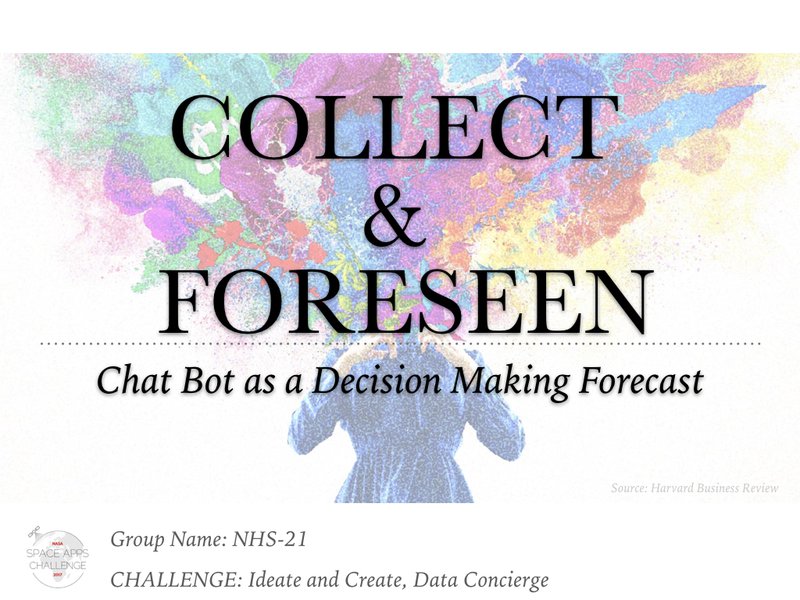NHS-21 | Data Concierge
The Challenge | Data Concierge
COLLECT & FORESEEN: Chatbot as a Decision Making Forecast
COLLECT & FORESEEN aims to forecast people's decisions.

Background
Over 90% victims in 311 tsunami, Japan, died from drowning. Most of them were drown because the evacuated places were not safe, or they were stuck in the traffic jam. The critical reason to this catastrophe, was that THEY HAVE NO CHANCE TO CONSIDER THEIR DECISIONS BEFORE THE EVENT.
Issue
How do we know people's decisions in certain scenarios before the events?
Method
- BUILD SCENARIOS. Gather data from open databases, for examples, NASA, USGS, etc., to build kinds of scenarios.
- COLLECT DATA. Collect users decisions in kinds of scenarios through our CHATBOT.
- ANALYZE DATA. Analyze the collected data to identify varied decision making patterns.
- PROMOTE THE MODULE. Promote the CHATBOT MODULE via social media, such as Facebook, to increase the efficiency of data collecting.
Feature
- SCENARIO ORIENTED. Give users a chance to consider their decisions and consequences in certain scenarios before the event happens, without losing their properties, including LIVES.
- ECONOMICAL AND EFFECTIVE. This method could be very low-cost yet effective in terms of data collecting.
- FORECAST EXTENSIVELY. Since the users' attributes could be collected, identifying certain decision making patterns of certain groups is also feasible, thus to forecast much more extensively.
Impact
- LOWER DISASTER MORTALITY. Since users have chances to face the scenarios before the events, the mortality rates during disasters should decrease.
- IMPROVE POLICY QUALITY. Since the decisions making forecast could be much more extensively, the policy in disaster management might be improved.
- INCREASE NASA EXPOSURE. Promote the CHATBOT MODULE through social media is low-cost yet effective. For example, the reach to 20,000 people costs only 30 USD per day on Facebook. Therefore, this method could effectively increase NASA's exposure to the public.
Improvement
To increase the reality of our simulated scenarios, varied data input is necessary. Hence, we would like to imply more devices (VR, joy sticks, fitness equipments) to solve the problem.
Further Implication
This project is a UNIVERSAL DECISION MAKING FORECAST. Further implication of the project, including the recruitment of NASA's employees (astronauts, engineers, researchers), or the data that could only be validated by human (images, sounds, ..., etc.) now.
SpaceApps is a NASA incubator innovation program.